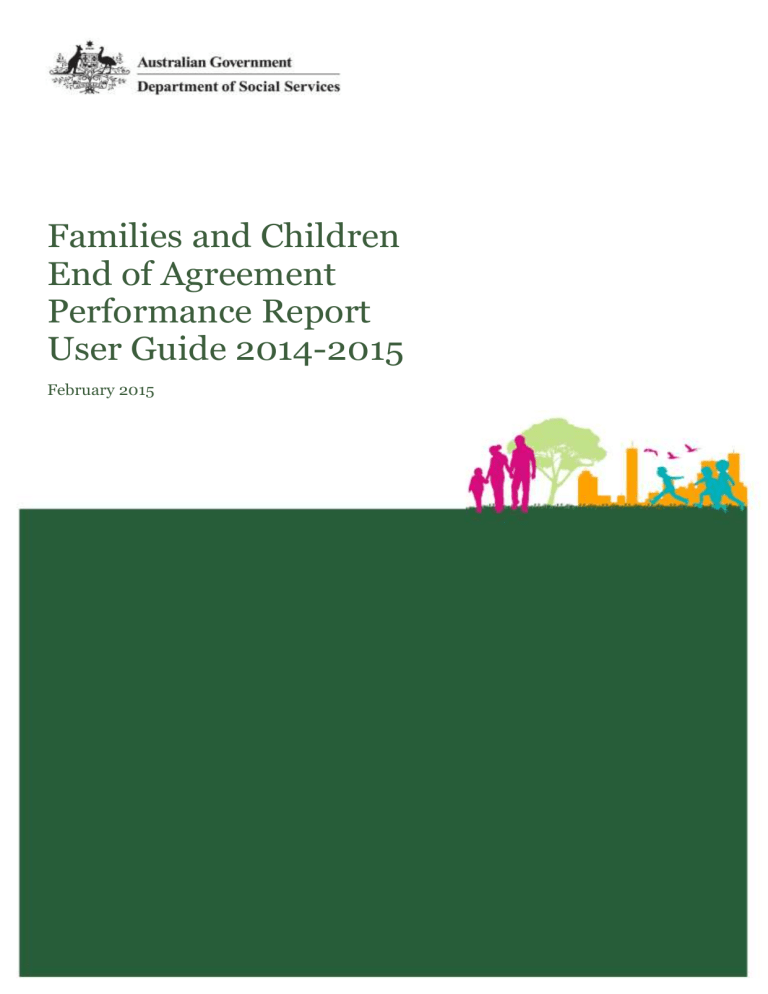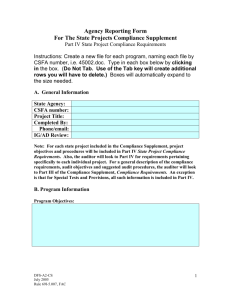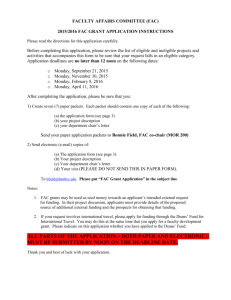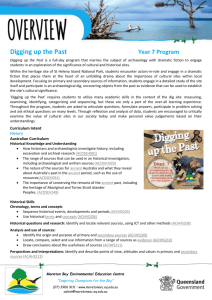Guide to Completing the End of Agreement Performance Report

Families and Children
End of Agreement
Performance Report
User Guide 2014-2015
February 2015
Families and Children End of Agreement Performance Report User Guide – February 2015
Contents
Families and Children End of Agreement Performance Report User Guide – February 2015
What is the Performance Report?
The Report is designed to collect programme information from Families and Children (FaC) providers to support ongoing funding for the Families and Communities Programme (FCP).
Providers who deliver the following Families and Children services will be required to submit a
Performance Report for the period 1 July 2014 to 28 February 2015 by 30 April 2015:
Communities for Children Direct
Community Playgroups
Intensive Family Support Service
How your information is used
The End of Agreement Performance Report is designed to gather the necessary information to
:
Assess your performance in meeting your Grant Agreement deliverables and fulfilling the requirements of the FaC Performance Framework .
Assess the overall performance of the FaC Activity within the FaC Performance Framework.
Fulfil departmental obligations to: o Promote the efficient, effective, economical and ethical use of Commonwealth funding as required by the Public Governance, Performance and Accountability Act 2013; o Report against the Department’s Key Performance Indicators in its Annual Report to
Parliament; and o Inform the Minister of progress towards programme outcomes.
PDF template
The template is developed using Smartform technology, which gathers data in a uniform manner that is automatically attributed against the correct provider and Activity in the Department’s funding management system (FOFMS).
Organisations funded to deliver more than one Activity must complete a separate template for each
Activity delivered. Once issued, a template cannot be transferred to a different funded Activity.
It is therefore important that details for each Activity are entered into the correct template, identified by the prefilled Activity Title and Activity ID details printed on the front page of the template.
Service Providers participating in the Family Support Program Data System (FSPDS) Data Trial will not be asked to complete the Client Data or Key Service Activities parts of the template.
To fit into system capabilities, the template includes limits on the size of text boxes, with the maximum number of characters or words identified where relevant. Providers may submit further information as attachments.
Families and Children End of Agreement Performance Report User Guide – February 2015
Improvements made to the End of Agreement Report
The Government’s red tape reduction programme aims to reduce unnecessary regulation and red tape costs on business, community organisations, and individuals.
The following questions have been removed from the End of Agreement template:
• ‘Objectives – What did you plan to achieve’ question;
• ‘With which Outcome does this activity align’ question;
• The ‘What Works’ section;
• The ‘Additional Information/Feedback’ section;
• The question asking for further comments on client outcome data collection; and
• The VADCAS questions.
Part 2: Client data – Who have you assisted this reporting period?
A client is anyone who receives a direct FaC service. This term is used generically and encompasses similar terminology such as ‘participant’, ‘member’ and ‘customer’.
Those who enjoy a flow on benefit from a family member’s access to FaC services are not counted as clients.
Example: If a mother and her child receive direct case management services, other family members may benefit indirectly from this service (e.g. siblings); however only the mother and child are counted as clients.
A direct service is a service delivered to a client by a FaC provider with the specific intent to contribute to achieving a FaC outcome.
Please read the introductory notes and examples and provide details of all clients who have attended your service and received a direct service.
Note:
Community Playgroup Associations should provide details of current playgroup association members and their children;
Providers who do not deliver direct services to clients – e.g. peak bodies, services who only undertake research or deliver web based activities, etc. should enter ‘0’ at 1a and are not required to complete further questions in Part 1;
Where possible, provide a count of unique clients. i.e. if a client attends more than one of your service activities, count that person only once, rather than once per service activity;
Do not include clients who:
Attended promotional events and family fun days;
Received straightforward referrals and were redirected to another service; or
Received assistance that involved the provision of information, with no direct participation in your service.
Families and Children End of Agreement Performance Report User Guide – February 2015
1. How many clients participated directly in eligible activities?
a) Total Clients
Record (by age group) all clients who received a FaC service during the reporting period.
Of the clients in 1a, how many have identified themselves as: b) c)
Aboriginal or Torres Strait Islander?
Record the total number of clients who identify as Aboriginal or Torres Strait Islander.
Why? People of Aboriginal or Torres Strait Islander descent are a priority target group for FaC services.
The percentage of FaC clients who are of Aboriginal or Torres Strait Islander descent is published in the Department’s Annual Report.
Culturally and Linguistically Diverse (CaLD)?
Record the total number of clients who were born overseas and who speak little or no
English at home.
Do not include any Aboriginal or Torres Strait Islander clients in this count.
Why? Those whose cultural and/or linguistic diversity presents a disadvantage to fully participating in the community (e.g. poor language skills inhibit participation in education, employment, social activities) are a priority group for FaC services.
The percentage of FaC clients who are CaLD is a known ‘vulnerable and at-risk of disadvantage ’ priority target group and reported in the Department’s Annual Report. d) Having a disability
Record all clients who have a disability that affects their quality of life and/or hinders their ability to fully participate in the community, e.g. participation in education, employment, social activities.
Why? People with a disability are known to be at greater risk of disadvantage. FaC uses this as a proxy measure for vulnerability.
2. How would you describe each adult client identified at 1a?
Count each of the adult clients who attended your service in one of the categories listed. The total of clients listed in questions 2a) to 2f) must be equal to the total adults listed in 1 a).
Do not count youth who are also parents here. This section collects data on adult demographics only. Young parents are recorded in the next set of categories section.
All adult clients who do not fit into categories a) to e) should be entered at f).
Why? Analysis of this data provides an insight into the level of:
Services provided to demographic groups of particular interest to FaC and
Professional skills development and community capacity building provided by FaC.
3. How many of the clients at 1a) fall into the following categories?
Record all clients (adults, youth and children) who fall into any of the demographic categories listed. Include clients as in as many categories as relevant. a) Young parents <20
Why? Young parents less than 20 years and their children are particularly vulnerable to disadvantage and are a priority target group for FaC services.
Families and Children End of Agreement Performance Report User Guide – February 2015 b) Young parents 20-25
Why? Young parents, 20-25 years may be at risk of disadvantage. c) From a family whose main source of income is believed to be from Centrelink or Department of Veterans’ Affairs
If services collect this data for their own purposes, or if it is appropriate to ask clients for this information, services should report this figure.
Where appropriate, the provider may use professional judgement to answer this question.
Providers are not expected to ask clients for this information in a way that causes distress or if it is inappropriate to do so. Discuss alternatives with your Grant
Agreement Manager.
Why? Income support is used as a proxy measure of disadvantage and vulnerability. d) From a family known to have Centrelink income support payments subject to income management.
This data is only required of providers who have reason to collect this information.
Why? Responses will be used to compare against the BAFW trial site results. e) From a family known to be referred by, or involved with, child protection.
Provide this if your service has received a warm referral from a child protection agency or if your service works in collaboration with child protection in relation to a client.
This data is only required of providers who have reason to collect this information.
Why? This is used to assess the extent of FaC collaboration with Child Protection
Agencies in line with the National Framework for Protecting Australia’s Children
2009–2020.
Families and Children End of Agreement Performance Report User Guide – February 2015
Part 3: Key Service Activities
Key service activities are the individual components of a service provider’s FaC service delivery.
Each service activity includes all components that, in combination, contribute towards a common initiative. e.g. a provider delivers the “Education for a Future” initiative, that aims to promote positive education outcomes for children of newly arrived refugee families. While including the individual components for out of school hours groups, parent education support and casework, the Education for a Future” initiative is one key service activity.
Providers should think about how each service activity works toward achieving FaC outcomes. This provides data in a format that:
Reduces the amount of mandatory data required, while allowing providers to present additional information if they wish; and
Allows plenty of room to provide additional information that providers feel is important, including in the form of an attachment if necessary.
This Report only requires information about your performance in achieving FaC outcomes .
Providing details of day-to-day activities that are unrelated to achieving FaC outcomes is not necessary.
Complete only one Key Service Activity sub-form entry per service activity. The aim is to gather necessary service activity information, reducing the time taken to complete the report.
New service activity sub-forms can be added as required (up to a limit of 25). If your organisation delivers more than 25 service activities, these may be attached as separate documents.
Note: if attaching additional service activity information, ensure that the same format used in the
Performance Report template is followed.
There are five questions for each service activity sub-form. The first four focus on collecting information about what was achieved rather than a detailed description of how it was achieved. This provides the key information required for FaC assessment.
The final question allows additional information to be provided about the service that is used to assess individual service performance. Supporting detail can be attached if desired.
Examples
1.
A provider delivers kindy gym in four different locations, to four different client demographic groups. This should be reported as one service activity, with any differentiating details of the four different groups (e.g. if a particular target group, or different community partner) included against the final question in Part titled Key
Service Activities.
2.
A provider delivers a “Building Better Parks” community strategy which aims to involve a number of communities in improving their local parks. The strategy involves engaging community organisations and businesses, a promotion campaign, community forums, weekend busy bees, a colouring competition for school children and family group activities. This would be included as one service activity which might be recorded as follows:
Title: Building Better Parks
Type of Activity : community development/capacity building
Outputs: at the demographic question select NO – as the programme is aimed at the whole community
Outcome Statement: Parktown businesses and residents have built a stronger sense of community, developed skills, and established new connections and friendships while collaborating to plan, design and construct safe, quality community spaces for their families.
Narrative describing the individual components, their achievements, client groups, etc. would be included against the final question in Key Service Activities.
Families and Children End of Agreement Performance Report User Guide – February 2015
What were the key service activities undertaken to deliver your service?
a) Title of activity
This should be a descriptive name for the service activity only. b) Type of activity
Select the most appropriate value from the pick list. The “other” category should only be selected where your service activity clearly does not fit with one of the categories listed.
If more than one category in the pick list is applicable to your activity, select the category that best describes the main focus of the activity. If required, further explanation can be included at the final question in Key Service Activities.
Why? These activity service types were designed to be generic rather than specific to enable the types of services to be categorised and analysed for mapping and planning purposes, including the identification of service gaps. They were derived from the most commonly reported service types in past reports.
Examples
1.
A provider delivers the ‘Education for a Future’ initiative that aims to promote positive education outcomes for children of newly arrived refugee families. The initiative involves school hours groups, parent education support and casework. Rather than selecting the
‘other’ category (and listing all components e.g. ‘out of school program’, ‘parenting/family skills training’ and ‘case management’), select the following one category:
Type of Activity : Multidisciplinary/Whole Family
2.
A provider delivers a kindy gym in four different locations, to four different client demographic groups. This would be recorded as one service activity. The kindy gym employs a family support worker who assists parents with referrals and parenting/family skills sessions are also arranged as part of the program. Rather than selecting the ‘other’ category (and listing all components e.g. Early childhood, Parenting/family skills training and referral for ATSI children and families), select the following single category:
Type of Activity : early childhood
For each example above, narrative describing the individual components would be included against the final question in Key Service Activities. c) Suburb/town/community where this activity was delivered?
Include the location name/s of where the service activity is delivered.
If service activity is delivered in multiple nearby locations, the regional name may be recorded instead. For example, record the City of Logan rather than listing five individual suburbs within the City of Logan.
Total clients for the activity for this reporting period
Record the total clients who participated in this service activity during the reporting period. If a non-direct service type that has no direct clients e.g. Community Development, enter ‘0’.
Was this activity designed for or targeted at clients from a particular demographic group/s?
Select ‘Yes’ only if the service activity is designed for or targeted at a particular demographic group.
If designed for a specific target group but open to all families with young children, tick ‘Yes’ and record only those clients in the target demographic.
Do not include details of untargeted demographic groups. If the activity is designed for a generic audience, but happens to be attended by participants who share a common demographic background, select ‘No’. More details may be included in the question: How was the activity delivered?
Families and Children End of Agreement Performance Report User Guide – February 2015
Example
Activity and focus
Attendees
For particular demographic group/s?
What would be recorded
Demographic
What would be recorded
-Count
Family Day activity
35 women/mothers,
22 men/fathers,
66 children.
No NA
Family Day activity for families who live in remote geographical areas
Information day for families of a child with disability
Parenting Program
Parenting support for Grandparent carers
35 women/mothers,
22 men/fathers,
66 children
35 women/mothers,
22 men/fathers,
26 children with disability
40 siblings.
12 Mothers
8 fathers
6 grandparents
12 grandparents
2 kinship carers
Yes
Yes
No
Yes
Isolated families
People with a disability; and/or family/carers
NA
Grandparents/ kinship carers
123
123
14
Why? The data assists the Department to identify services designed for and delivered to specific demographic groups in response to local need. It also identifies where specific demographic groups are located and what their needs may be.
Demographic group/s targeted
If ‘Yes’ is selected for the above question, this section should be completed. Up to three demographic groups per service activity can be selected from the pick list.
Select the most appropriate value from the pick list where possible. If your service activity is targeted to more than three listed demographic groups, select the main three.
The ‘other’ category should only be selected where your service activity clearly does not fit with one of the categories listed. Do not use the “other” category to further refine an existing category. More information may be entered at the final question in Part 3 if necessary.
Why? The demographic group options are designed to be generic rather than specific to enable demographics to be readily analysed for mapping and planning purposes. Values were derived from the most commonly reported demographics in past reports.
Enter the number of clients who attended from each group.
Note: Individual demographic groups need not be mutually exclusive. If applicable, a client may be recorded against more than one demographic group. Therefore the sum of clients recorded here may exceed the total clients entered for the service activity.
Example: A total of 100 clients attended a playgroup activity designed for young Aboriginal and
Torres Strait Islander parents. Of the 100 total clients attended the activity:
50 were young parents but only 30 of these were Aboriginal and Torres Strait Islander clients; and
50 clients were children 0<5 but only 30 of these were Aboriginal and Torres Strait Islander clients
Families and Children End of Agreement Performance Report User Guide – February 2015
The number of clients would be entered as follows:
1.
Aboriginal and Torres Strait Islander (60)
2.
Young parents <20 (50)
3.
Children 0-5 years (50)
What outcomes has this activity achieved?
Provide a precise statement or abstract that summarises the activity specific outcomes achieved by this service activity.
Example: Socially isolated parents were taught new social skills in a casual, supportive environment and encouraged to engage in their community.
Do not describe the methods used to achieve outcomes
Example: A playgroup was run two days per week for socially isolated parents. This should be provided under ‘any additional comments about the service activity’.
Do not enter a prescribed FaC Outcome here.
Why? This provides specific information on what each service activity is meant to achieve. When collated, this information will build a picture of the varied elements involved in achieving the FaC
Performance Framework Outcomes.
How was the activity delivered?
This is a free text field where you can include all qualitative information that may be required for your
Agreement Manager to properly assess your performance.
Information reported here should include:
A description of the service activity (keep details precise and relevant to the FaC);
An explanation of the community need/s this activity addresses;
Unexpected outcomes or achievements, if any; and/or
Challenges to achieving desired outcomes and strategies used to overcome those challenges, if any.
Enter text directly into the box.
Why? This information provides a precise snap shot of:
what your service activity is doing
the issues in the community where the service activity is delivered and
how you are working to address these issues
Families and Children End of Agreement Performance Report User Guide – February 2015
Part 4: Deliverables
Were there any challenges in meeting the deliverables?
Include information about anything that made it difficult to achieve your agreed deliverables.
Why? This helps Agreement managers to assess your performance and for the Department to identify any trends or significant issues that may need to be addressed.
Which deliverables have not been met and why? Please provide details below.
Column 1 – copy deliverable from your Funding Agreement Schedule.
Column 2 – provide a summary of the reasons this deliverable could not be met.
Column 3 – provide brief details of the strategies you plan to use to meet the deliverable.
Why? This allows Agreement Managers to understand your circumstances and your plans to address any difficulties.
Advised the relevant Grant Agreement Manager of all changes to service?
It is a requirement of the FaC Funding Agreement that, if you change a delivery location during the reporting period, you must advise the Department of the changes within 30 Business Days.
Why? Accurate service delivery location information is required to meet the Department’s reporting requirements, and to accurately understand where services are delivered.
Part 5: Performance Indicators of Client Outcomes
For a more detailed guidance about collecting immediate client feedback, refer to the FSP
Performance Framework Help Guide.
Immediate outcomes (or client feedback) are client outcomes expected as a result of the FaC in the short term and are collected at or near the time of service.
From 2013, all FaC providers must address all four immediate performance indicators unless an exemption has been granted in writing by DSS.
Completing the Table
Complete the table using data collected through your survey processes using the following notes:
Multiple questions may be listed against each Performance Indicator;
Only one response per Performance Indicator per client;
The number of responses in the ‘Yes’, ‘No’ and ‘Don’t Know’ columns must equal the total responses;
Where an exemption has been granted in writing by DSS, enter Not Applicable (N/A) for the question and zero in table columns;
Intermediate Performance Indicators are not required. Please enter N/A.
Families and Children End of Agreement Performance Report User Guide – February 2015
Part 6: Statement of Compliance against Approval
Requirements
The FAC Activity Administrative Approval Requirements are a set of 15 quality service standards, covering the five key risk areas of governance, financial management, viability, performance management and issues management that must be complied with under the terms of FaC Grant
Agreements.
If relevant, verify that all statements against approval requirements are representative of all consortium members or subcontracting arrangements.
Complete the table using the drop list to select if your organisation was ‘fully compliant’, ‘partially compliant’ or ‘non-compliant’ against each of the Approval Requirements.
If your organisation does not fully comply with an Approval Requirement, enter details of your plan to ensure future compliance, including timelines, in the final column.
Why? This information is used to monitor and assess compliance rates across the programme.
You are not required to provide evidence of compliance in the table but your Grant Agreement
Manager may require evidence to be supplied separately.
Families and Children End of Agreement Performance Report User Guide – February 2015
Additional Information
FCP Objectives
All FCP services work towards the following aim:
To support families, improve children’s wellbeing and increase participation of vulnerable people in community life to enhance family and community functioning.
FaC Objectives
Key objectives are to:
strengthen relationships,
support families,
improve children’s wellbeing and increase the participation in community life to strengthen family and community functioning, and
reduce the costs of family breakdown.
FaC Outcomes
Long Term Outcomes:
• Improved child, adult and family functioning
• Increased economic engagement
• More cohesive communities
Intermediate Outcomes:
• Improved adult functioning
• Improved family functioning
• Improved child wellbeing
• Improved community functioning
Immediate Outcomes:
• Increased personal agency
• Stronger family relationships
• Increased parental capacity
• More cooperative post-separation arrangements
• Increased positive community connectedness
Service quality Outcomes:
• Increased use of evidence-based practice
• Increased use of early intervention and prevention
• Increased service integration and collaboration
• Improved access for vulnerable or disadvantaged individuals and families
Families and Children End of Agreement Performance Report User Guide – February 2015
Types of Activity
Category from Drop Down List
Advocacy
Antenatal/postnatal
Case Management/therapy Speech Therapy and Speech Awareness
Whole of family therapy program
Community development/capacity building Improved access to recreation, sporting facilities via community infrastructure redevelopment programs
Cultural awareness/support Closing the Gap strategy - enhancing Indigenous understanding
Development/disability
Drug & alcohol education/support
Special needs program
Alcohol and other Drugs Residential Treatment Program for parents and their accompanying children
Perinatal & Family Drug Mothers drop in clinic
Smoke, Alcohol & Drug Free Family Fun Day
Early Childhood
Examples include
Co-ordinated Advocacy for Referral and Early Intervention in Schools Strategy
Future Parenting Program
Pregnancy support group, First time Mother’s group
Family Counselling/support
Family Violence/safety/awareness
Granparent/Carer Support
Indigenous early years focussed network
Child Health Checks
Mobile Toy and Parenting Resource Service
Specialist Child and Family Support Program
Men's Behaviour Change Group for men with a history of abusive behaviour
My Time for Grandparents
Health & nutrition education/support
Home visits/outreach
In-school/Mentoring program
Interagency/collaboration/linkages
Peer support for Kinship Carers
Cooking activity and playgroup for young children 0-5 years
Visiting Parent Mentors
In school Anti-Bullying Program
Mentoring program for vulnerable children / youth
Create linkages with Aboriginal organisations to develop trust and create soft entry pathways
Literacy/Numeracy
Men/fathers program
Mental Health
Multidisciplinary / Whole Family
Out of school program
Parenting/family skills training
Peer support/social networking
Playgroup
Professional training / development
Rainbow Readers Program
Learning Centre
Mentoring and demonstration of positive male role models and learning
Building Self Worth Program
Multidisciplinary services
Family Liaison Worker, Needs assessment
Camp/holiday program/after school program
Superkids - afterschool kids program
1, 2, 3 Magic Workshops
Financial Literacy and Advocacy for Young Parents
Support Group for Aboriginal Kinship Carers
Supported playgroup
Volunteer training
Train the trainer program
Promotions/Referral/Information
Resource development/research
Respite/volunteer program
Distribution of information and resources to support parenting practices
Development of online training course
Voluntary Respite
Volunteer support with at risk children and families
School readiness
Training/personal development
Positive Start to School Program
Social, Emotional and Life Skill Development
Program for teenage girls at risk of disengaging
Growing Strong Families and Families Together
Families and Children End of Agreement Performance Report User Guide – February 2015
Demographic Target Groups
Category from Drop Down List:
• Aboriginal and/or Torres Strait Islander;
• CaLD;
• Carers;
• Children at risk;
• Early Childhood Professionals;
• Grandparent/Kinship carers;
• Homelessness;
• Isolated families;
• Jobless families;
• Men//Fathers;
• People with a disability;
• Pre-school/Infants;
• Primary school aged;
• Secondary school aged;
• Single parents;
• Socially isolated families;
• Women/Mothers;
• Young Parents/Expectant Parents (<20); and
• Young Parents/Expectant Parents (20 to 25)







